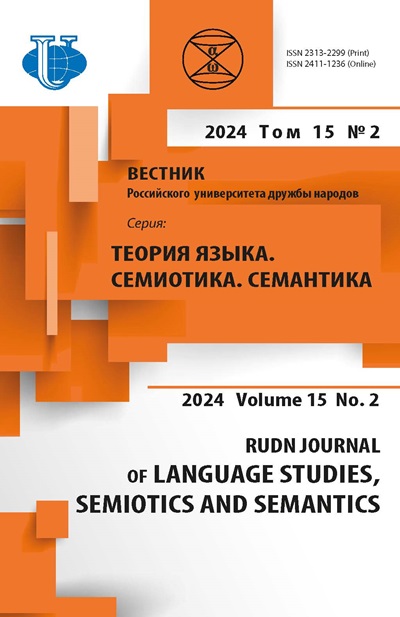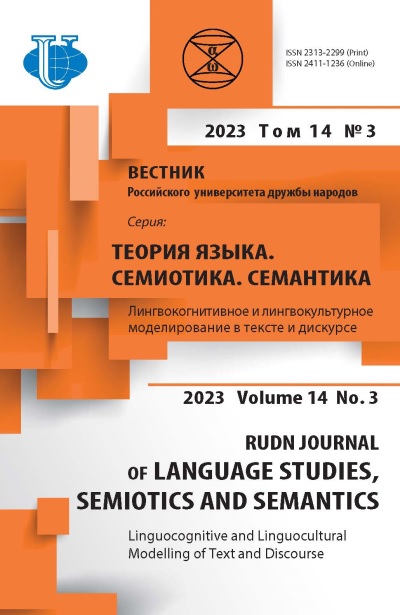Geopoetic Image as a Cultural Token, Process and Result of Aesthetic Reality Modeling
- Authors: Novikova M.L.1, Markelova T.V.2
-
Affiliations:
- RUDN University
- Institute of Modern Arts
- Issue: Vol 14, No 3 (2023): LINGUOCOGNITIVE AND LINGUOCULTURAL MODELLING OF TEXT AND DISCOURSE
- Pages: 658-685
- Section: COGNITIVE RESEARCH
- URL: https://journals.rudn.ru/semiotics-semantics/article/view/36453
- DOI: https://doi.org/10.22363/2313-2299-2023-14-3-658-685
- EDN: https://elibrary.ru/JXICOC
Cite item
Full Text
Abstract
The research field of geopoetics as the theory of studying creative forms and ways of human interaction with the geographic space, the multidimensional concept shaped by the syncretic perception of reality, is expanding dynamically in the aspect of space interpretation and modeling. Such research prism facilitates addressing projective meanings of the modeled reality, studying geopoetic image as a cultural sign, process and result of aesthetic display and representation of reality. Taking into account the relevance of the problem, the authors of the article set a goal to investigate the semiotic triad of St. Petersburg, the emotional component of the axiological model and its semantic transformations: Petropol’ - Petrograd - Leningrad, that permits to present a multilateral description of geopoetic image modifications. The research logic is dictated by the fact that the conceptualization of space in its various manifestations is associated with the study of the territory as an object of aesthetic reflection. The study analyzes creative embodiment of a particular toponym in its dual rational and emotional essence as a fact of verbal art. Transformation and treatment of geopoetic image meanings of St. Petersburg based on the spheres of urban semiotics are analyzed in the aspect of giving new meanings and semantics to the place in the context of spatial and cultural historical relations and models. The authors argue that geopoetic image is a special representation of geographical space in its historical and cultural, value and semantic nature and fusion in their unity. The existing territory can be presented as a compact axiological model through the “prism” of socio-cultural values, signs and symbols. Actualization of the palimpsest concept based on the combination of textual layers, research of peculiarities of structural meaning modeling enable addressing the reconstruction of the semiotic system and variant semantics of “city mirror” texts.
About the authors
Marina L. Novikova
RUDN University
Author for correspondence.
Email: novikova-ml@rudn.ru
ORCID iD: 0000-0002-4673-067X
SPIN-code: 1502-9636
D.Sc. (Philology), Professor, Russian Language Department, Institute of Law
6, Miklukho-Maklaya Str, Moscow, Russian Federation, 117198Tatyana V. Markelova
Institute of Modern Arts
Email: tvmarkelova@mail.ru
ORCID iD: 0000-0003-4400-6175
SPIN-code: 4862-5769
D.Sc. (Philology), Professor, First Vice-Rector - Vice-Rector for Academic Affairs
27A, Novozavodskaya street, Moscow, Russian Federation, 121309References
- Novikov, L.A. (2001). Selected works. Vol. II. Aesthetic aspects of language. Miscellanea. Vol. II. Moscow: RUDN Publ. (In Russ.).
- Heidegger, M. (2008). The source of artistic creation. Moscow: Academic Project. (In Russ.).
- Tynyanov, Yu.N. (2004). The problem of poetic language. Moscow: Editorial—URSS. (In Russ.).
- Segal, D. (1979). Literatura kak vtorichnaja modelirujushhaja Sistema. Slavica -Hierosolymitana, IV, 1–35. (In Russ.).
- Lotman, Yu.M. (1998). The structure of a literary text. In: About Art. Saint Petersburg: Iskusstvo. pp. 12–150. (In Russ.).
- Yu.M. Lotman and the Tartu-Moscow semiotic school (1994). Moscow: Gnosis. (In Russ.).
- Morris, C.W. (1983). The foundation of the theory of signs. In: Semiotics. Moscow: Raduga. pp. 37–89. (In Russ.).
- Poselyagin, N.V. (2010). On the concept of “secondary modeling systems”: from the history of early Russian structuralism. RUDN Journal of Language Studies, Semiotics and Semantics, 1(1), 13–20. (In Russ.).
- Agranovich, S.Z. & Stepansky, E.E. (2003). Myth in a word: continuation of life. Samara: Samara Humanitarian Academy publ. (In Russ.).
- Potebnya, A.A. (1990). Theoretical poetics. Moscow: Vysshaya shkola. (In Russ.).
- Gosetti, Ferencei J. (2012). The World and Image of Poetic Language: Heidegger and Blanchot. Continental Philosophy Review, 45, 189–212.
- Gadamer, G.G. (1991). Language and understanding. In: Actuality of the beautiful. Moscow: Iskusstvo. рр. 43–60. (In Russ.).
- Denisenko, V.N. (2010). Modeling of the language system in the aspect of linguistic personality. RUDN Journal of Language Studies, Semiotics and Semantics, 1(1), 6–12. (In Russ.).
- Karasik, V.I. (2013). Language matrix of culture. Moscow: Gnosis. (In Russ.).
- Eco, U. (2004). Missing structure. Introduction to semiology. Saint Petersburg: Symposium. (In Russ.).
- Lavrenova, O.A. (2020). Annals of the International Association of Semiotics of Space and Time. Man: Image and Essence. Humanitarian aspects, 1(41), 218–227. (In Russ.).
- Sid, I. (2015). History of the concept of geopoetics. Vestnik of Moscow State Linguistic University. Humanities, 11(722), 153–170. (In Russ.).
- Zamyatin, D.N. (2003). Humanitarian geography: space and language of geographical images. Saint Petersburg: Aletheia. (In Russ.).
- Novikova, M.L. (2017). Axiology of artistic space through the prism of geopoetics. RUDN Journal of Language Studies, Semiotics and Semantics, 8(1), 115–123. https://doi.org/10.22363/2313-2299-2017-8-1-115-123 (In Russ.).
- White, K. (2023). Vast field of geopoetics. URL: https://www.institutgeopoetique.org/fr (accessed: 14.03.23). (In Russ.).
- Berdyaev, N.A. (1990). Russian idea. In: About Russia and Russian philosophical culture. Moscow: Nauka. pp. 5–42 (In Russ.).
- Krasina, E.A. & Chesnokova, O.S. (2019). “Story” by H.L. Borges: the experience of intertextual reading. Tomsk State University Journal of Philology, 57, 206–223. https://doi.org/10.17223/19986645/57/13 (In Russ.).
- Abashev, V.V. & Abasheva, M.P. (2012). Literature and geography. Perm University Herald. History, 2, 143–151. (In Russ.).
- Gilford, J. (1965). Three sides of the intellect of tasks. In: Psychology of thinking. Moscow: Progress. pp. 433–457. (In Russ.).
- Lotman, Yu.M. (2002). Symbolism of St. Petersburg and problems of the semiotics of the city. In: History and typology of Russian culture. Saint Petersburg: Iskusstvo—SPB. pp. 208–220. (In Russ.).
- Yaroshevsky, M.G. (1976). History of psychology. Moscow: Mysl’. (In Russ.).
- Gadamer, H.-G. (1988). Truth and method: Fundamentals of philosophical hermeneutics. Moscow: Progress. (In Russ.).
- Aleksandrova-Osokina, O.N. (2020). Issues of Geopoetics in Modern Literary Studies. Scientific Dialogue, 5, 216–241. (In Russ.).
- Lotman, Yu.M. (2000). Semiosphere. Saint Petersburg: Iskusstvo—Saint Petersburg. (In Russ.).
- Toporov, V.N. (2003). Petersburg Text of Russian Literature: Selected Works. Saint Petersburg: Art-Saint Petersburg. (In Russ.).
- Urbanc, M. & Printsmann, A. (2004). Comprehension of Rapidly Transforming Landscapes of Central and Eastern Europe in the 20th Century. Acta Geographica Slovenica, 44(2), 101–131.
- Kryukova, E.V. (2020). On the issue of the receptive side of the palimpsest. RSUH/RGGU Bulletin “Literary Theory. Linguistics. Cultural Studies” Series, 9, 179–187. https://doi.org/10.28995/2686-7249-2020-9-179-187 (In Russ.).
- Isaev, S.G. & Vladimirova, N.G. (2017). Actual poetics: Change of artistic paradigm. Veliky Novgorod: NovGU im. Yaroslav the Wise. (In Russ.).
- Zakharov, V.P. & Masevich, A.Ts. (2016). Methods of corpus linguistics in historical and cultural studies. In: Collection of scientific articles of the XIX Joint Conference “Internet and Modern Society”. Saint Petersburg: ITMO University Publ. pp. 24–43. (In Russ.).
- Paliychuk, D.A. (2022). Corpus technologies in linguistic research. Humanitarian Studies. History and Philology, 6, 72–79. (In Russ.).
- Vendler, Z.O. (1981). About the word good. In: New in foreign linguistics. Iss. 11. Moscow: Progress. pp. 530–554. (In Russ.).
- Chertov, L.F. (2020). About semiotization and resemiotization of city space. Man: Image and Essence. Humanitarian aspects, 1(41), 78–90. https://doi.org/10.31249/chel/2020.01.05 (In Russ.).
- Shakhovsky, V.I. (1986). Meaning and emotive valence of units of language and speech. Problems of linguistics, 2, 97–103. (In Russ.).
- Epstein, M.N. (1991). Ideology and language (building a model and comprehending discourse). Voprosy Jazykoznanija, 6, 18–28. (In Russ.).
- Markelova, T.V. (2019). Sign-pragmeme as a semiotic dominant of the axiological field. RUDN Journal of Language Studies, Semiotics and Semantics, 10(3), 581–592. https://doi.org/10.22363/2313-2299-2019-10-3-581-592 (In Russ.).
- Morris, Ch. (1956). Varieties of human value. Chicago; University of Chicago Press.
Supplementary files


















